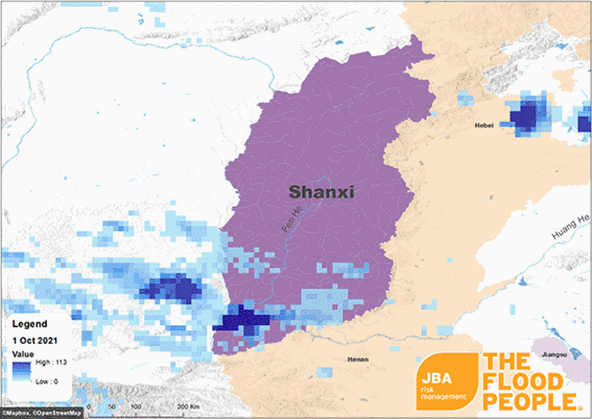Autumn floods along the Huang He and Fen He rivers, October 2021
Recent torrential downpours in north-eastern China have caused catastrophic impacts in many cities within Shanxi province, including in its capital, Taiyuan, with 29 fatalities in the region. The event occurred over 14 days (1 to 14 October 2021) with the heaviest rainfall occurring over a 5-day period, from 2-7 October (1, Floodlist, 2021a).
Unlike the last exceptional rainfall event, experienced in Henan in July, October is not a month where heavy rainfall is expected. At 185mm, the rainfall in Taiyuan over a 12-hour period was the highest recorded rainfall on record for October in this area. This is seven times the pre-2010 overall average for the same month (2, The Guardian, 2021).
This significant event is closely related to several causes including atmospheric circulation patterns, abundant moisture and terrain (3, CGTN, 2021a; 14, Tellereport, 2021).
According to the China Meteorological Administration, a stable area of high pressure to the east and low pressure to the west formed over Shanxi which set up the necessary conditions for long-term rainfall. Water vapour from the South China Sea and the Bay of Bengal is continuously transported towards the central and southern parts of Shanxi, providing an abundant source of water vapour to generate continuous rainfall.
As the air flows up and over high ground across Shanxi - such as the complex terrain of the Luliang and Taihang mountains – it cools, enabling large amounts of moisture to condense and lead to further heavy rainfall (3, CGTN, 2021).
Additionally, since late August, warm and cold air has been meeting over the Huang He River (also known as the Yellow River), causing the water vapour in the air to condense into clouds and cause rainfall in large quantities (see Rainfall section) (4, CGTN, 2021b).
As of 20 October, 29 fatalities have been recorded, with 1.76 million people affected and economic losses reaching 5.02 billion yuan, or about USD $780 million (6, SCMP, 2021; 7, NYTimes, 2021).
Rainfall
According to multiple rainfall gauges in Shanxi, the rainfall experienced between 2 and 7 October was above any historical records.
In the space of 12 hours, a weather station in Taiyuan recorded 185.5mm of rainfall, which is over three times higher than the historical recorded maximum (between 1979-2021), and over seven times higher than the average October precipitation amount of 25mm observed between 1981 and 2010 (9, BBC News, 2021a). The highest rainfall total (285.2mm) was recorded in Daning County in south-west Shanxi, exceeding the local record by seven times within only 12 hours.
Across the entire province, rainfall averaged 119.5mm over the 12 hours between 2 and 3 October, compared to the usual monthly total of 31.3mm. Over the course of five days, Shanxi received more than three times the average monthly rainfall for October (2, The Guardian, 2021; 10, NDTV, 2021).
Overall, 63 national weather monitoring stations in the province saw the accumulated precipitation figures reach record highs (17, Shine, 2021).
 Figure 1: Video showing daily rainfall between 1 to 14 October 2021 over Shanxi, China. (Data source: NASA PPM, 2021; video produced by JBA Risk Management Limited.)
Figure 1: Video showing daily rainfall between 1 to 14 October 2021 over Shanxi, China. (Data source: NASA PPM, 2021; video produced by JBA Risk Management Limited.)
EVT Analysis
Extreme Value Theory (EVT) can be used to determine the return period of significant precipitation events, measured as daily precipitation in mm. Table 1 shows the results of the EVT analysis for daily precipitation across both Taiyuan and Daning counties.
Both counties witnessed extremely high rainfall amounts during the Shanxi floods, suggesting greater than 1-in-1500 return period when compared against the results of the EVT analysis. However, the short historic record (42 years) makes it difficult to accurately determine the return period with a high degree of certainty.
 Table 1: Return periods derived from EVT based on highest daily rainfall recorded between 1979 – 2021. Values have been rounded up to two decimal places.
Table 1: Return periods derived from EVT based on highest daily rainfall recorded between 1979 – 2021. Values have been rounded up to two decimal places.
Detail on areas affected
Shanxi is a landlocked province located in the north-east of China; its capital Taiyuan is located on the Fen He river, one of the largest tributaries of the Huang He river.
Due to the record-breaking levels of rainfall on 2 October, its maximum flow of water reached 1,100 cubic metres per second, more than 20 times its usual rate and its highest water level since 1996 (13, Straits Times, 2021; 14, Tellerreport, 2021; 17, Shine, 2021).
Due to this level of water flow, several dykes - including one in Jishan - breached causing severe flooding in Yuncheng in south-west Shanxi near the confluence of the Fen He and Huang He rivers (1, Floodlist, 2021a). Additionally, the Xinjiang section burst its banks, causing flooding.
Other water management features also failed, as dams collapsed on several sections of the Wuma river, forcing 18,000 people from eight villages to abandon their homes (6, SCMP, 2021).
Overall, flooding in Shanxi has affected more than 1.76 million people in 76 different counties (16, China daily, 2021; 7, NY Times, 2021), causing 29 fatalities and triggering landslides. Around 19,500 houses have collapsed, with 120,100 people having to be relocated (17, Shine 2021).
Crop land was also affected, with the flooding damaging around 248,460 hectares of grain. The flooding has led to direct economic losses of 5.029 billion yuan or about USD $780 million (21, Breaking Latest News, 2021).
Flooding from the Fen He river has also impacted cultural sites, causing damage to 1,763 relic sites, including a 25-foot section in Pingyao, a preserved medieval city along the Fen He river (15, CN News, 2021). Following the damage, many tourist sites were forced to close for repairs.
 The province of Shanxi is best known for being China’s largest coal producing region with a total of 670 mines (11, Washington Post, 2021; 12, Global Times, 2021). Out of these, 60 were forced to suspend production due to the torrential rainfall, at a time when the country was already experiencing an energy crisis (12, Global Times, 2021).
The province of Shanxi is best known for being China’s largest coal producing region with a total of 670 mines (11, Washington Post, 2021; 12, Global Times, 2021). Out of these, 60 were forced to suspend production due to the torrential rainfall, at a time when the country was already experiencing an energy crisis (12, Global Times, 2021).
Figure 2 (right): Spatial analysis conducted by JBA showing the location of Shanxi coal mines in comparison to a 200-year return period river flood extents from JBA’s China flood map. The locations of the coal mines are sourced from USGS (24, 2021).
Notable historical events
Shanxi has had a number of historical flood events of significance.
Many of these occurred during the rainy season with much more extensive rainfall coverage (Table 2), whereas the October event experienced an unusual amount of rainfall for this time of year and could be an indication of how events may change under a changing climate.
 Table 2: Historical events and reported losses for severe flood events in Shanxi, China from 1988 to 2016 (Sources: 26, Reliefweb, 1988, 27, Reliefweb, 2012, 28, Floodlist, 2016.)
Table 2: Historical events and reported losses for severe flood events in Shanxi, China from 1988 to 2016 (Sources: 26, Reliefweb, 1988, 27, Reliefweb, 2012, 28, Floodlist, 2016.)
Climate change impacts and future implications
Following the summer 2021 floods in New York, Europe and Henan, the severity of the rainfall and flooding has drawn further attention to the effects of climate change in the days leading up to the COP26 summit (5, World Economic Forum, 2021).
An outline released by China’s central government on 8 October notes that floods caused by climate change and extreme weather pose a threat to nearly a million people in the Huang He River area, despite the improvements and flood defences installed (16, China Daily, 2021).
Over the past year, most of China’s central and northern areas have seen exceptionally wet weather, with multiple flood events such as the recent Henan and Shanxi floods (22, Republic World, 2021). The Heng Hu River has already experienced its third flood of the season (25, CGTN, 2021).
Many studies are concluding that climate change is making extreme flooding worse, with the number of people exposed to these flood threats since 2000 ten times higher than previously estimated (23, CNN, 2021) - this has the potential to severely impact Shanxi, and China more widely, in the future.
It’s vital that organisations act now in response to flood risk. We offer flood mapping and probabilistic flood modelling worldwide, including for China, which provides flood risk insights at any location globally. This can help re/insurers, financial organisations, and the International Development sector to better understand and manage flood risk.
To find out more about our flood data and how it can help you, get in touch with the team.
This report is covered by JBA’s website terms – please read them here.
References
(1) https://floodlist.com/asia/china-floods-shanxi-october-2021
(2) https://www.theguardian.com/world/2021/oct/11/flooding-in-china-forces-120000-to-flee-homes-amid-record-rainfall
(3) https://news.cgtn.com/news/2021-10-12/Why-has-Shanxi-suffered-from-heavy-rains-floods--14ibRhLaDtu/index.html
(4) https://news.cgtn.com/news/2021-10-11/Why-the-Yellow-River-autumn-floods-are-so-fierce-this-year-14gxSeH8Dny/index.html
(5) https://www.weforum.org/agenda/2021/10/flood-risk-is-rising-here-s-where-and-what-can-be-done-about-it/
(6) https://www.scmp.com/news/china/politics/article/3151839/five-dead-thousands-displaced-floods-chinas-shanxi-province
(7) https://www.nytimes.com/2021/10/12/world/asia/china-bus-flooding-dead.html
(8) https://www.weatheronline.co.uk/weather/maps/forecastmaps?LANG=en&UP=0&R=0&MORE=1&MAPS=vn&CONT=cncn&LAND=__&ZEIT=202110250600&LOOP=1
(9) https://www.bbc.com/news/world-asia-china-58866854
(10) https://www.ndtv.com/world-news/at-least-15-dead-millions-affected-after-heavy-rain-floods-in-chinas-shanxi-province-2572468
(11) https://www.washingtonpost.com/world/asia_pacific/china-floods-climate-coal-power/2021/10/11/c20a7d2e-2a6a-11ec-b17d-985c186de338_story.html
(12) https://www.globaltimes.cn/page/202110/1236562.shtml#:~:text=Of%20the%2060%20coal%20mines,influence%20on%20Shanxi's%20coal%20supply.
(13) https://www.straitstimes.com/asia/east-asia/thousands-evacuated-as-heavy-rain-and-flooding-hit-shanxi-and-shaanxi-in-china
(14) https://www.tellerreport.com/news/2021-10-12-13-times-over-the-same-period-in-history!-the-rain-disaster-in-shanxi-is-really-serious---.rJZhsbhGrY.html
(15) http://www.news.cn/english/2021-10/12/c_1310238751.htm
(16) https://global.chinadaily.com.cn/a/202110/19/WS616e17dfa310cdd39bc6fb5b.html
(17) https://www.shine.cn/news/nation/2110116202/
(18) https://www.independent.co.uk/climate-change/china-floods-bus-homes-evacuated-b1936122.html
(19) https://www.ft.com/content/041b24fb-e8bd-44dd-b546-5a5ff9c9f564
(20) https://www.bbc.co.uk/news/business-58879481
(21) https://www.breakinglatest.news/news/heavy-rainfall-caused-direct-economic-loss-of-5-029-billion-yuan-in-shanxis-15-deaths-due-to-disaster_china-it-news/
(22) https://www.republicworld.com/world-news/china/china-floods-in-shanxi-province-force-over-120000-people-to-flee-their-homes.html
(23) https://edition.cnn.com/2021/08/04/weather/global-flood-risk-climate-change/index.html
(24) https://pubs.er.usgs.gov/publication/ofr20141219
(25) https://news.cgtn.com/news/2021-10-07/China-s-Yellow-River-sees-third-flood-of-the-year-149Woa8ecVO/index.html
